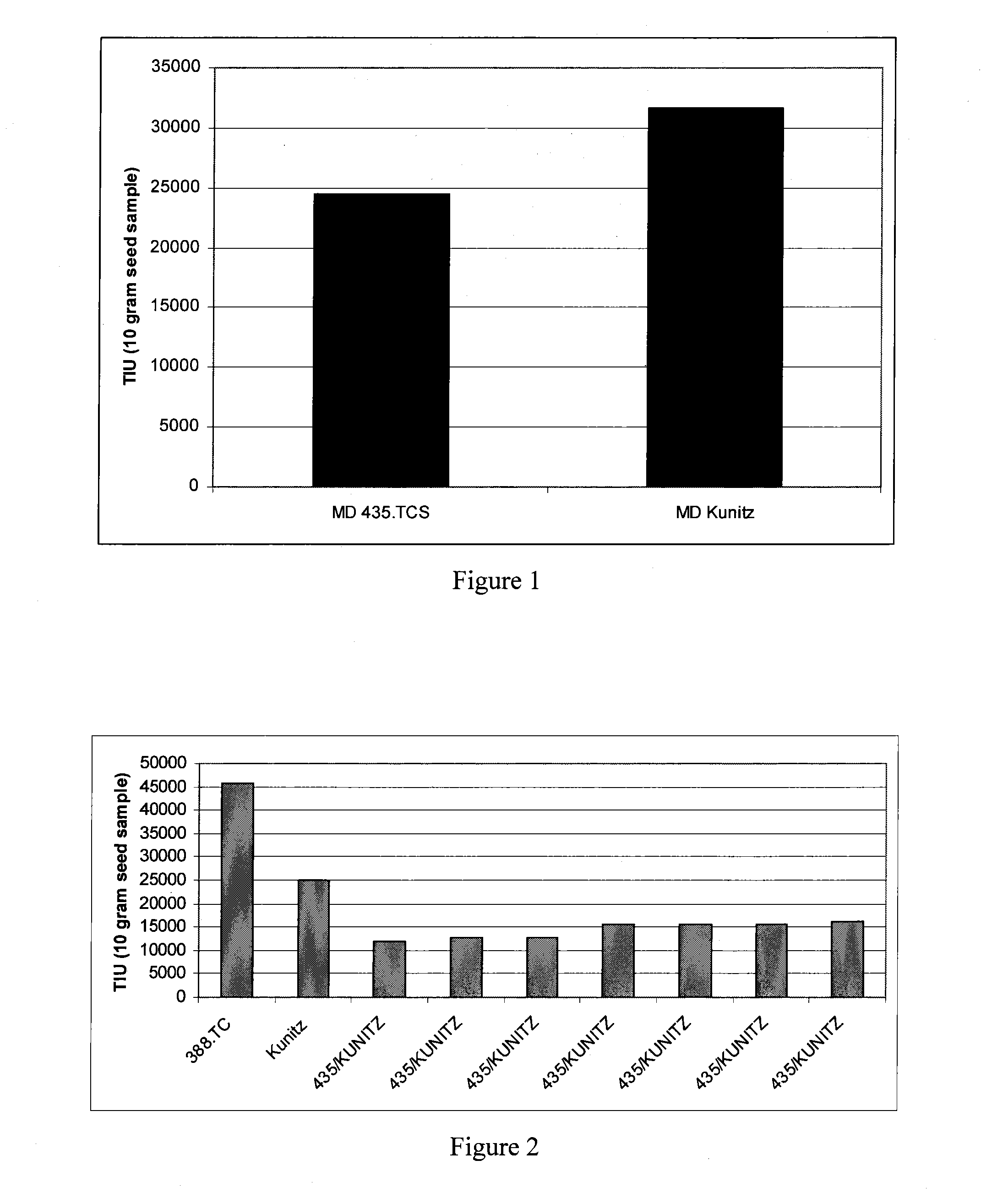Ultra-low trypsin inhibitor soybean
a trypsin inhibitor, ultra-low technology, applied in the direction of plant/algae/fungi/lichens, peptides, vegetable seeds, etc., can solve the problems of reducing the nutritive value of food ingested by the animal, concomitant deficiency of enzymes, and reducing the content of soybean trypsin inhibitors, etc., to achieve high-reduced soybean trypsin inhibitor content, simple and effective
- Summary
- Abstract
- Description
- Claims
- Application Information
AI Technical Summary
Benefits of technology
Problems solved by technology
Method used
Image
Examples
example 1
[0074]In the present application, newly derived soybeans having an ultra-low trypsin inhibitor content and activity that is lower than previously known Kunitz lines of soybeans have been developed. Trypsin inhibition activity is expressed in trypsin inhibitor units (TIU). These new ultra-low trypsin inhibitor soybeans resulted from crosses of proprietary 435.TCS soybean line with the Kunitz soybean line. The 435.TCS line was known from molecular testing to have a wild-type copy of the Kunitz allele. Thus, the observed reduction in trypsin inhibitor activity was due to a mutation at another locus, perhaps within one or more genes of the Bowman-Birk class of trypsin inhibitors. This separate allele is termed the SG-ULTI allele of the present invention. In 2009, the 435.TCS soybean line was approximately 23% lower trypsin inhibitor activity (FIG. 1) than the Kunitz line when grown side-by-side under identical conditions. This result was unexpected because the Kunitz variety has previou...
example 2
[0075]In 2009 we compared the Kunitz line to a commercial soybean line known as 388.TC and to several novel soybean lines produced by crossing the 435.TCS soybean line with the Kunitz soybean line (FIG. 2). The Kunitz line, carrying only the Kunitz mutation to reduce trypsin inhibitor activity, by itself had a reduction in activity of at least 45% compared to the commercial line, which carried neither the Kunitz allele, nor the SG-ULTI phenotype. When the Kunitz line was compared to the Kunitz×435.TCS hybrid progeny, these new progeny lines showed a further reduction in trypsin inhibitor activity of from about 36% to about 52%, when compared to the Kunitz line. These reductions in trypsin inhibitor activity in the Kunitz×435.TCS hybrid lines correspond to an overall reduction in trypsin inhibitor activity, compared to commercial soybean varieties, of about 65 to 74% in these samples. These results demonstrate the ultra-low trypsin inhibitor phenotype characteristic of the Kunitz×435...
example 3
[0076]An expanded experiment was conducted to compare several novel hybrid soybean lines to lines heterozygous for the Kunitz allele, to a line homozygous for the Kunitz allele, and to several lines that were wild type for the Kunitz allele. FIG. 3 demonstrates that while there is variability within each class of soybean line, clear differences between each class were observed.
[0077]These experiments were performed at two different sites in Maryland (one in Galena and another in Queenstown). While the Kunitz soybean line (Sample 47, FIG. 3) had a TIU of 25,000, the Kunitz×435.TCS hybrids achieved TIU values as low as 9,000. Even when the Kunitz gene is not mutated, 435.TCS samples reach TIU levels around 20,000 (data points 57 and 58). Many of the data points in this graph are from soybean lines which share similar pedigrees of Kunitz combined with the Schillinger Genetics variety 435.TCS (see FIG. 3).
PUM
| Property | Measurement | Unit |
|---|---|---|
| speeds | aaaaa | aaaaa |
| disease resistance | aaaaa | aaaaa |
| insect resistance | aaaaa | aaaaa |
Abstract
Description
Claims
Application Information
 Login to View More
Login to View More - R&D
- Intellectual Property
- Life Sciences
- Materials
- Tech Scout
- Unparalleled Data Quality
- Higher Quality Content
- 60% Fewer Hallucinations
Browse by: Latest US Patents, China's latest patents, Technical Efficacy Thesaurus, Application Domain, Technology Topic, Popular Technical Reports.
© 2025 PatSnap. All rights reserved.Legal|Privacy policy|Modern Slavery Act Transparency Statement|Sitemap|About US| Contact US: help@patsnap.com


